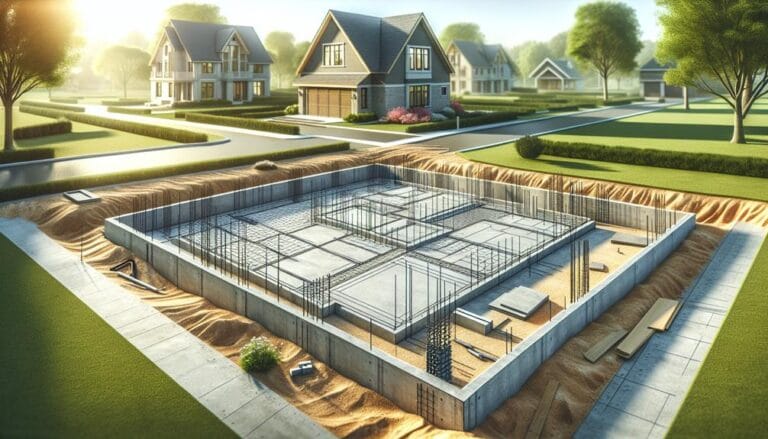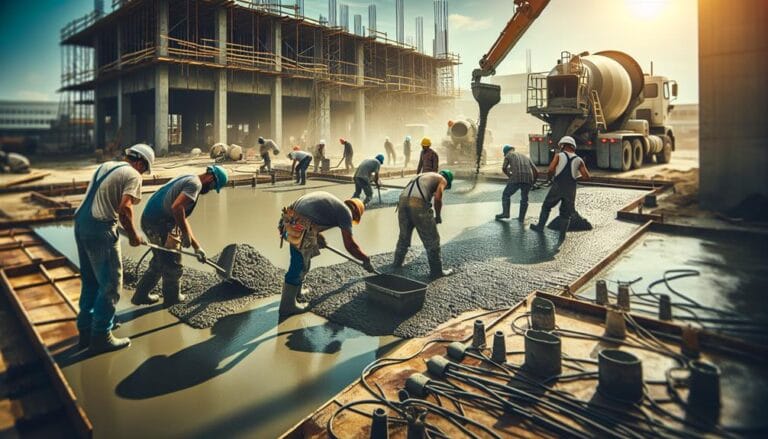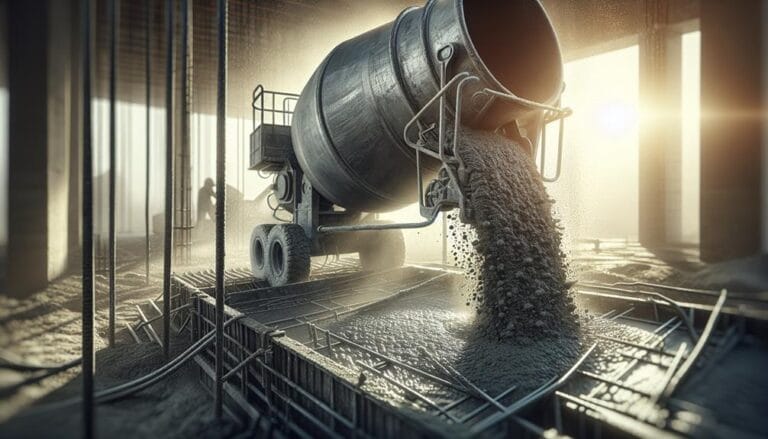Raising the Standard With Slab-On-Grade Foundations
We're breaking the mold by embracing slab-on-grade foundations for their exceptional strength, durability, and smart efficiency. Not only do they offer cost-effective construction with reduced excavation and materials, but they also provide homes with long-term energy savings and resistance to pests like termites. By ensuring proper site preparation, using high-performance insulation, and reinforcing the concrete, we can avoid issues like cracking and water damage. If we can overcome common challenges like settling and thermal expansion, this robust foundation type can revolutionize how we build and live.
Key Takeaways
- Slab-on-grade foundations are cost-effective due to reduced excavation and material use.
- Quick construction leads to faster project completion.
- Proper thermal performance, insulation, and management prevent cracks from temperature changes.
- Soil capacity assessment is crucial for stability and performance.
Why Slab-on-Grade Foundations
Why Slab-on-Grade Foundations
Slab-on-grade foundations have become a popular choice for residential and commercial projects, offering benefits such as cost-effectiveness, quick construction, and simplicity. The decision to go with a slab-on-grade foundation makes sense for those who prioritize efficiency and durability. One of the key advantages is cost efficiency. By eliminating the need for extensive excavation and the use of less material, construction time and expenses are notably reduced.
Another considerable advantage is the improved thermal performance. With proper insulation, slab-on-grade foundations provide better temperature control, which translates to energy savings. This is especially beneficial in warmer climates, where the risk of frost heave is low. Furthermore, slab-on-grade foundations are known for their exceptional durability and resistance to pests like termites, making them a sturdy choice for structures that need to stand the test of time. By choosing a slab-on-grade foundation, home and building owners can benefit from long-term cost savings and energy efficiency without compromising on strength and stability.
Designing for Strength and Durability
To guarantee the long-term stability and structural integrity of our structures, we must carefully design slab-on-grade foundations that can withstand various environmental and loads-generated stresses. This involves meticulous planning and execution to assure our foundations can handle the demands placed upon them.
Design Considerations
Here are three key design considerations for slab-on-grade foundations:
- Load Distribution: Properly distributing loads across the foundation is essential to preventing excessive stress concentrations. This involves calculating and managing the weight of the structure, occupants, and any additional external loads.
- Soil Capacity: The strength and stability of the soil beneath the slab greatly impact the overall foundation performance. We must assess and address any soil-related issues to prevent settlement and other problems.
- Thermal Performance: Thermal performance is also vital, as extreme temperature variations can affect the slab's expansion and contraction, leading to cracks and weaknesses.
Site Preparation and Planning
When planning a slab-on-grade foundation, we must now turn to preparing the site itself, ensuring that the groundwork is solid and ready for construction. This vital step includes site excavation and clearing, which sets the stage for a strong and balanced foundation. It begins with evaluating the site's soil conditions to identify potential challenges and determine the most suitable excavation techniques.
A thorough soil evaluation helps us understand the soil's density, moisture levels, and structural stability. This information allows us to select the right tools and methods for site preparation, ensuring that the soil can support the weight of the structure without settling unevenly. Proper site planning prevents future problems like cracks, water infiltration, and structural weakening. By investing in careful site preparation and evaluation, we guarantee a stable base for our slab-on-grade foundation and a robust structure that will stand the test of time.
Materials and Construction Techniques
Raising the Standard With Slab-On-Grade Foundations
Materials and Construction Techniques
We construct the slab-on-grade foundation by carefully preparing the ground and pouring concrete directly into a mold set into the ground, a process that is both sturdy and cost-effective. This method guarantees a solid base for our structures, eliminating the risks associated with settling and providing a durable foundation.
To guarantee the integrity of our slabs, we employ various materials and techniques. Here are some key elements:
- Insulation Options: We use high-performance insulation materials like foam to reduce heat transfer and minimize the impact of temperature fluctuations.
- Moisture Barriers: A layer of bitumen and gravel acts as a barrier to prevent water infiltration, maintaining a dry and stable slab.
- Reinforcement: Steel bars are strategically placed to fortify the concrete against tension and enhance its overall strength.
Common Applications and Benefits
Common Applications and Benefits
A slab-on-grade foundation offers numerous benefits, particularly in warmer climates. For starters, it's an energy-efficient choice as the foundation acts as a thermal mass, regulating the building's temperature throughout the year. This means lower energy bills and a more comfortable living or working environment.
From a cost perspective, slab-on-grade foundations are more economical compared to basement or crawl space foundations. The absence of excavation and lower material usage make them a financially attractive option. Furthermore, the construction process is generally faster, which reduces labor costs.
Slab-on-grade foundations also offer practical benefits. Since they don't have crawl spaces or basements, there are fewer areas to inspect and maintain, resulting in lower maintenance costs over time. In addition, the concrete slab is less susceptible to moisture and water damage, which reduces the risk of mold and mildew growth.
Potential Challenges and Solutions
While enjoying the benefits of slab-on-grade foundations, it is vital to confront the potential challenges that can arise, such as differential settlement caused by soil conditions and cracking from thermal expansion. As builders, we must remain vigilant about these issues to guarantee a strong and durable structure.
Challenges we often encounter:
- Soil Settlement: Improper soil preparation or the use of unsuitable subgrades can lead to cracks and settlement issues that compromise the integrity of the slab.
- Thermal Expansion: Changes in temperature can result in cracks, making it essential to incorporate proper joints and expansion control measures.
- Moisture Management: Poor drainage and inadequate moisture management can lead to erosion, weakening the slab's structural stability.
Frequently Asked Questions
Can Slab-On-Grade Foundations Be Used in Colder Climates?
In colder climates, we guarantee slab-on-grade foundations work by considering frost depth. We use insulation techniques like foam under the concrete to mitigate frost heave and guarantee the foundation remains stable and secure.
Are Slab-On-Grade Foundations Susceptible to Termite Infestation?
"We find that slab-on-grade foundations are less susceptible to termite infestation due to the lack of hollow space between the slab and the ground, making soil treatment and termite prevention more manageable."
Can Slab-On-Grade Foundations Be Extended or Remodeled?
We can face challenges with slab-on-grade foundations when looking to extend or remodel. This difficulty arises because these foundations lack hollow spaces underneath, which makes room for utility installations and modifications.
What Techniques Are Used to Repair Slab-On-Grade Foundations?
We utilize a variety of techniques to repair slab-on-grade foundations, including crack stabilization, ensuring the structural integrity of the concrete, and installing effective drainage solutions to prevent water damage and erosion.
Do Slab-On-Grade Foundations Provide Energy Efficiency?
We've discovered that slab-on-grade foundations greatly enhance energy efficiency. Benefits like insulation and cost savings make them perfect for ultra-high efficient net zero and passive houses.







